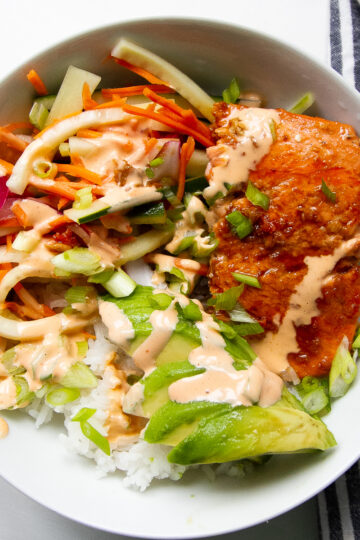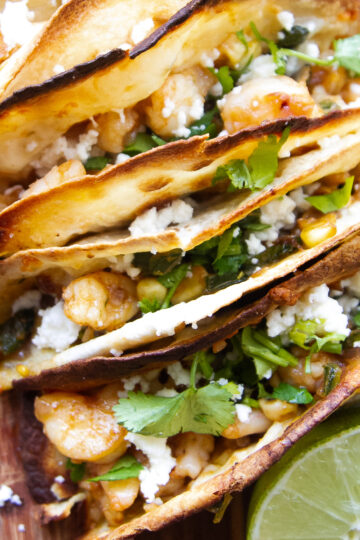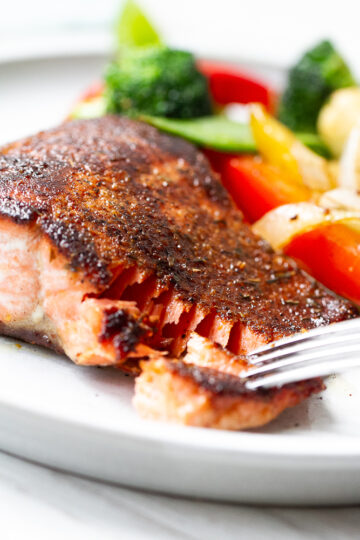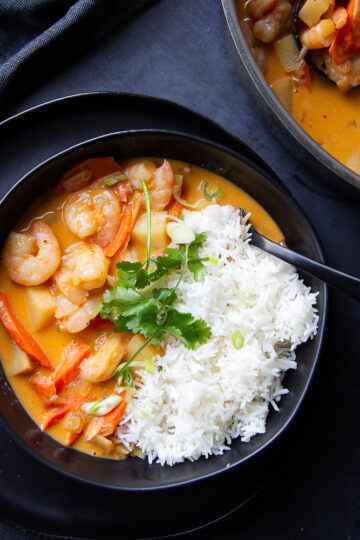This deliciously easy ramen noodle bowl is gluten-free and is packed with loads of shredded vegetables, rice noodles, tender shrimp, and a ginger-soy sauce.
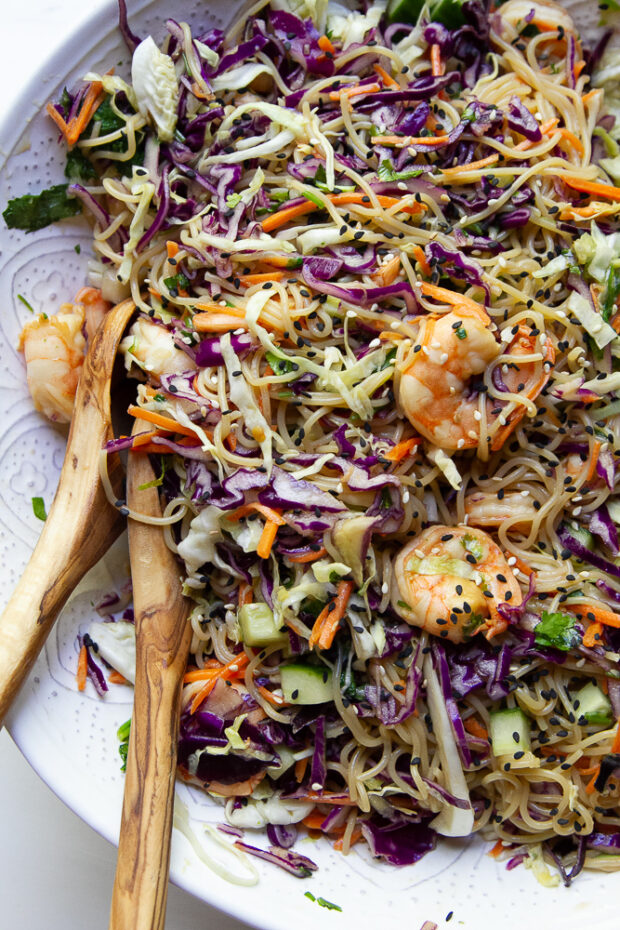
Gluten Free Ramen Noodle Bowl
I love taking carb-heavy recipes and finding ways to stuff them with vegetables. This gluten free ramen noodle bowl is the perfect example of that! I incorporated some pre-shredded vegetables and fresh herbs to make this cozy noodle bowl lighter and more nutritious!
Frozen shrimp is my favorite quick-prep protein to keep on hand for emergency meals. It thaws and cooks up SO quickly and is a blank slate for just about any flavor profile you can imagine.
If shrimp isn’t your thing, try using chicken! I included some recipe adaptations below to give you some ideas.
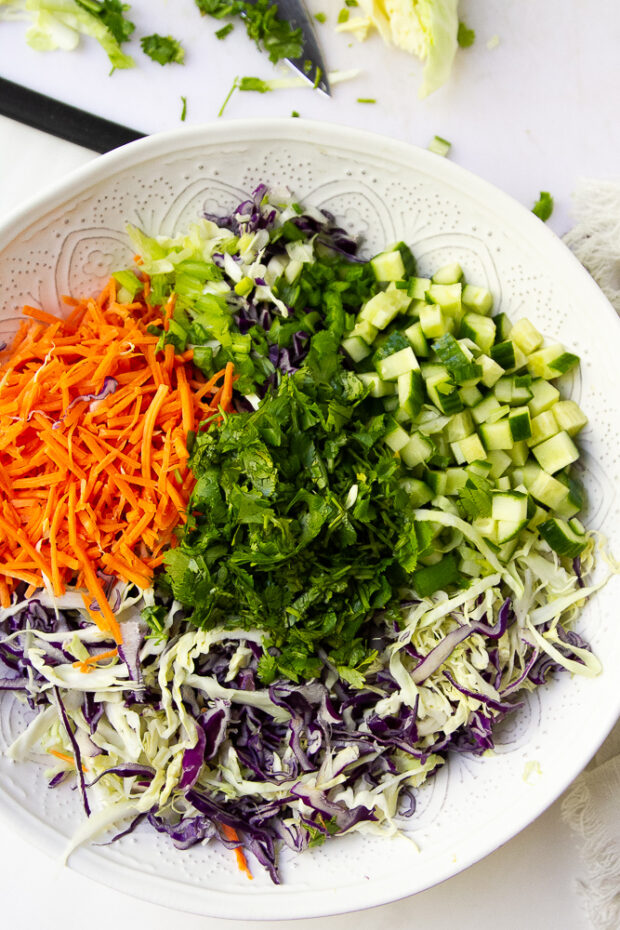
What's in the Shrimp & Vegetable Noodle Bowl?
For the salad base:
I used a mixture of...
- shredded cabbage
- shredded carrots
- diced cucumber
- thinly sliced green onions
- chopped cilantro.
The cabbage and carrots are easy to find pre-shredded which can save you loads of time. Unless you have a food processor, then it's not so bad. I love my Cuisinart food processor. I use it all the time.
I used a combination of green and purple cabbage because it's so pretty, but you can use whichever you want.
And if there's something in here you don't like, swap it out for somethi
ng different! Thinly sliced bell peppers or Napa cabbage would be good, too.
Just make sure you're using things that wilt easily when you pour the hot sauce and noodles over them.
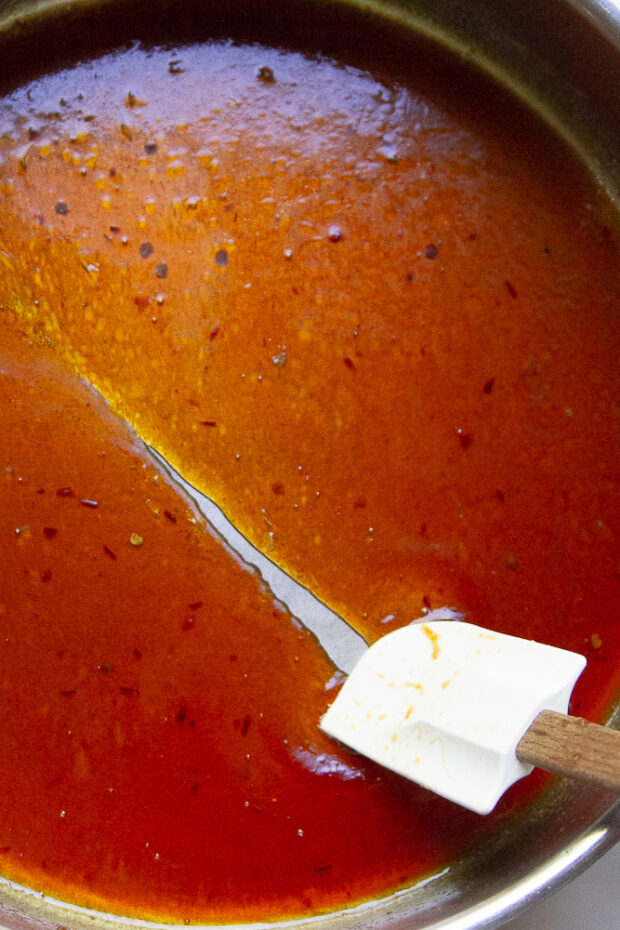
Gluten Free Ramen Sauce:
This sauce has all of my Asian pantry staples:
- tamari GF soy sauce (or coconut aminos)
- rice vinegar
- lime juice
- fresh ginger
- sesame oil
- sambal oelek (or sriracha)
- and honey for some sweetness
This sauce simmers for a while to reduce it to a slightly thicker, richer sauce. It has a lot of ground to cover to flavor the noodles and shrimp and vegetables!
I also reduced it so it wouldn't be too watery. The shrimp and vegetables both release some moisture, so I took that into account.
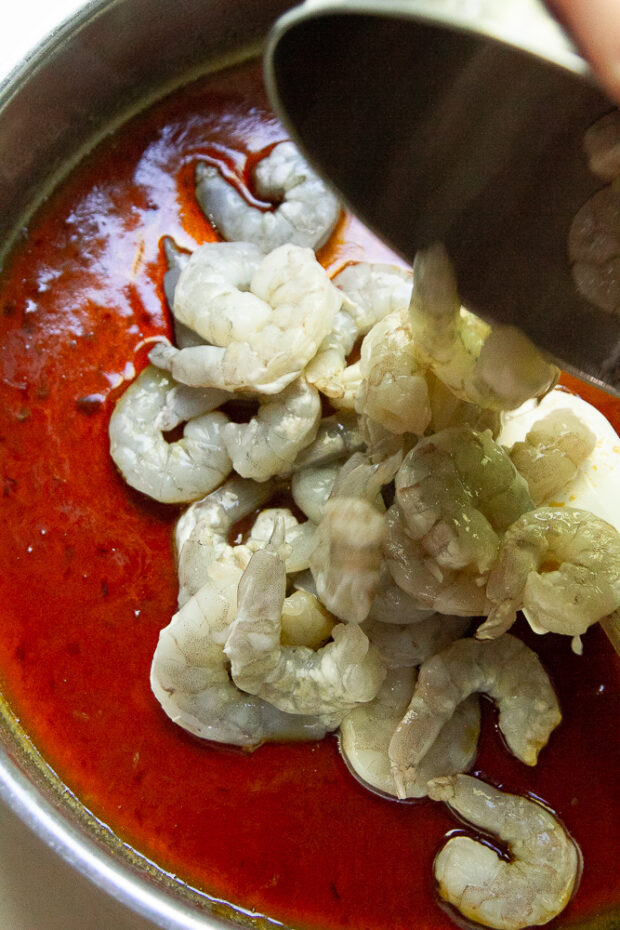
Protein and Noodles:
I used shrimp here because it cooks really quickly and goes so well with Asian-type flavors.
If shrimp isn't your thing, you can use uncooked chunks of chicken or pork. Or thinly sliced beef. Mmm.
You can also make it vegetarian or vegan by leaving out the protein altogether or using tofu if that's your thing.
Last, the rice ramen noodles
I really love the Lotus Foods brand rice ramen noodles I find at Costco. They're gluten-free and made from brown rice and millet and are super tasty.
I like them better than regular rice noodles, but you can use those, too if you want. I'd recommend pad Thai noodles for this recipe if you go that route.
How to make Ramen (Gluten Free)
- Cook the rice ramen noodles in boiling water.
- Make the sauce by adding the honey, tamari, vinegar, lime juice, ginger, sesame oil, and sambal/sriracha to a large skillet over high heat. Bring to a boil, and let it cook for 5-10 minutes until the mixture has reduced by half.
- Grab a very large salad bowl and add the cabbage, carrots, cucumber, green onions, and cilantro.
- Add the shrimp to the sauce and cook for 4-5 minutes or until the shrimp is just cooked through and completely pink.
- Drain the ramen and toss with the shrimp. Pour the whole mixture over the cabbage mixture in the large salad bowl. Toss everything together really well.
- Serve immediately.
Gluten Free Ramen Recipe Variations
Can I use zucchini noodles in place of rice noodles?
Sure! If you want this recipe to be grain-free or lower carb, spiralize 3 medium-sized zucchini noodles, put them in a colander with a sprinkle of salt and let them sit for 20 minutes to release some of the moisture.
Squeeze them out a bit and then add them to the reduced sauce when the recipe says to.
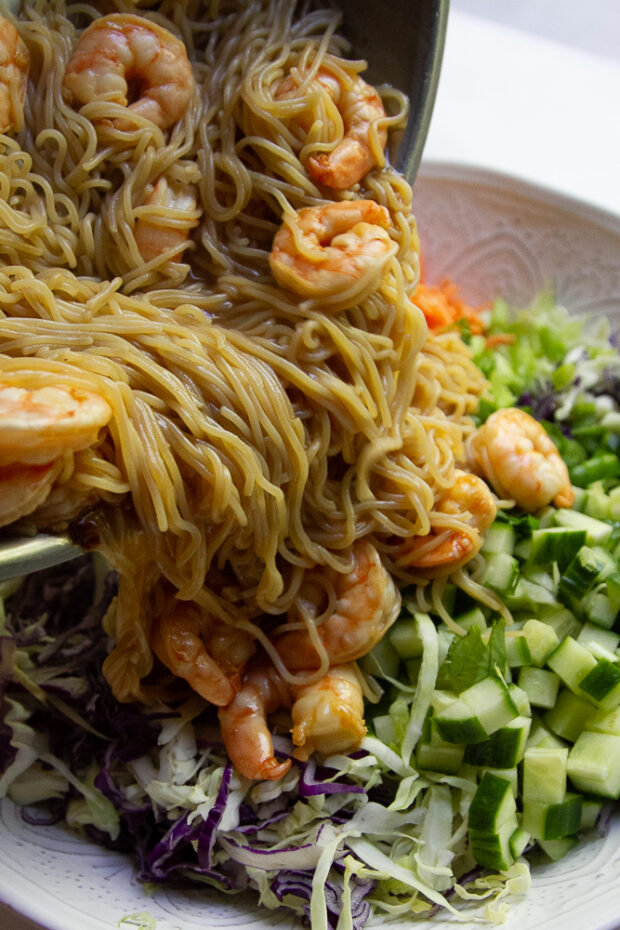
Here are a few ways you can adapt this recipe:
- Swap out the shrimp for thinly sliced chicken, steak, or pork.
- Make it meatless by using your favorite tofu or a couple cans of chickpeas in place of the shrimp.
- Use a bag of broccoli slaw in place of the cabbage (or in addition to).
- Make it spicy by adding more sriracha or sambal to the noodle sauce.
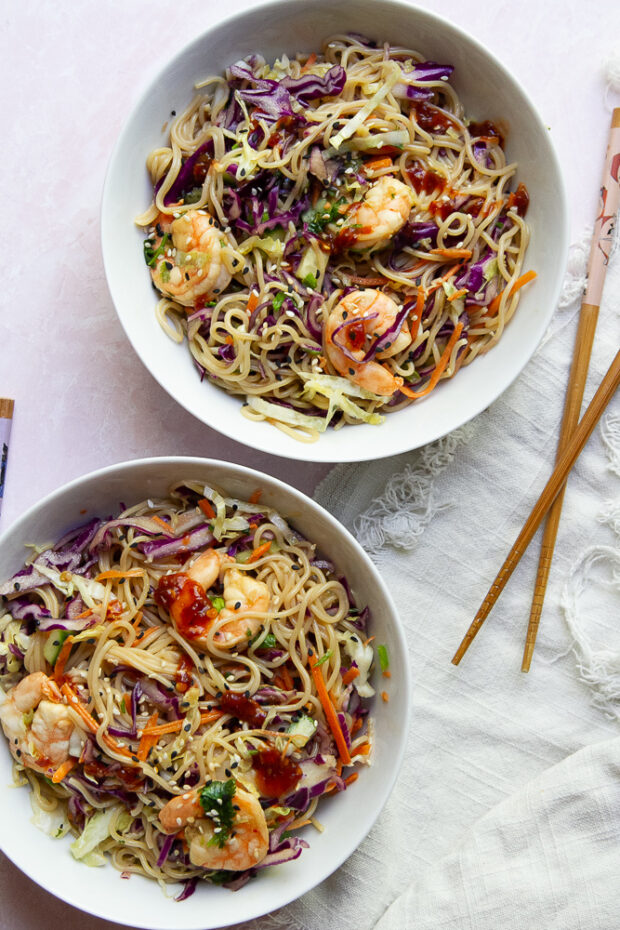
Gluten Free Ramen Topping Ideas
Here are a few topping ideas!
- Toasted Sesame Seeds
- Sriracha, Sambal Oelek, or another Asian style chili sauce
- Furikake Seasoning
- Coconut Aminos or Tamari Soy Sauce
- Spicy Mayo (Mix mayonnaise with sriracha, a squeeze of lime, and a pinch of salt until you get the flavor you like.)
More Noodle/Zoodle Recipes on Perry's Plate
Easy Paleo Pad Thai -- one of our family's favorite meals! Another tasty meal with shrimp and quick cooking vegetables. You'll love this one with either rice noodles or zucchini noodles.
Pesto Noodles with Bacon & Broccoli -- This was the very first thing I ever made with zoodles. Before we were calling them zoodles! Pesto + bacon + broccoli is a fabulous combination.
Thai Green Curry Zoodles with Shrimp & Broccoli -- A Thai inspired zoodle recipe based on a dish I ate at Noodles & Co!
Creamy Spinach Avocado Pasta -- A creamy avocado-yogurt based sauce dresses whatever kind of pasta you like!
If you make one of my recipes, I'd love to see! Post it on social media and tag me at @perrysplate or #perrysplate so I can send you some love!
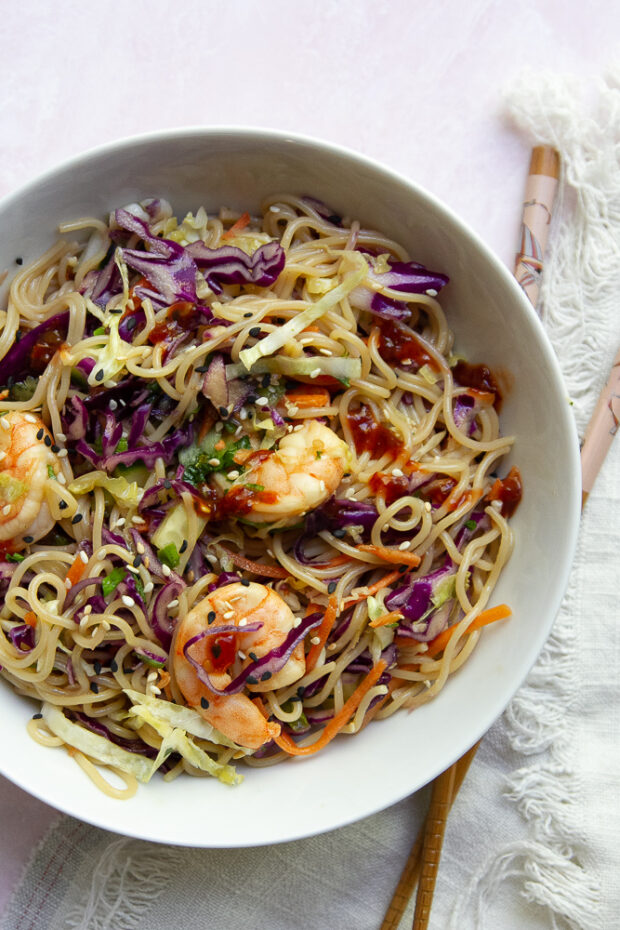
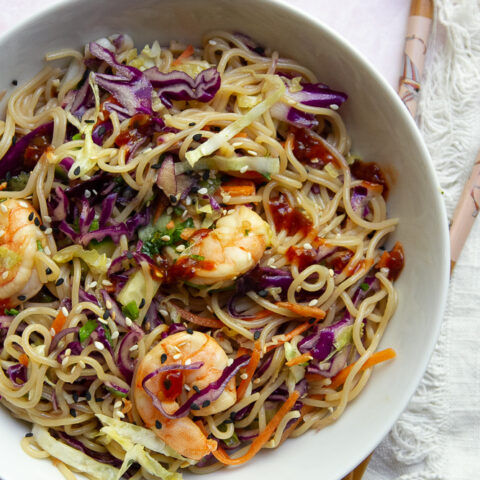
Gluten Free Ramen Recipe
This deliciously easy noodle bowl is gluten-free and is packed with loads of shredded vegetables, rice noodles, tender shrimp, and a ginger-soy dressing.
Ingredients
- 4 uncooked, unflavored rice ramen cakes (9-10 oz total)
- ⅓ cup honey
- ½ cup gluten-free soy sauce (tamari) or coconut aminos
- ¼ cup rice vinegar
- Juice from 1 lime
- 2 Tablespoons grated fresh ginger
- 2 Tablespoon sesame oil
- 1-3 teaspoons sambal oelek or sriracha
- 1 pound shredded cabbage
- 4 ounces shredded carrots (about 1 ½ cups)
- ½ English cucumber, diced
- 3 green onions, thinly sliced
- ½ cup chopped fresh cilantro
- 1 pound shrimp, peeled & tails removed
- Sesame seeds and more sambal/sriracha, for serving
Instructions
- Bring a large pot of water to a rolling boil. Add the salt to the water. Add the rice ramen cakes and cook according to package directions. Usually the rice-millet kind needs to be broken up with a fork halfway through cooking.
- While you're waiting for the water to boil, Add the honey, tamari, vinegar, lime juice, ginger, sesame oil, and sambal/sriracha to a large skillet over high heat. Bring to a boil, and let it cook for 5-10 minutes until the mixture has reduced by half. It shouldn't be syrupy, but you should be able to swip a spatula down the middle and see the bottom of the pan for a second or two before the sauce comes back together.
- While you're waiting for the ramen and the simmering sauce, grab a very large salad bowl and add the cabbage, carrots, cucumber, green onions, and cilantro.
- When the sauce is finished, add the shrimp to the skillet and cook for 4-5 minutes or until the shrimp is just cooked through and completely pink. Remove the pan from the heat.
- When the rice ramen is cooked through, drain thoroughly, and then add the noodles to the pan with the shrimp. Toss it around to combine, then pour the whole mixture over the cabbage mixture in the large salad bowl.
- Use a pair of tongs to mix everything together well, grabbing vegetables from the bottom to ensure everything is coated in the sauce.
- Serve immediately with a sprinkle of sesame seeds and a drizzle of sambal or sriracha, if desired.
Notes
- I buy the rice ramen noodles (Lotus Foods brand) at Costco. If you don't want to use those particular noodles, you can use regular rice noodles -- I'd recommend flat pad Thai noodles for this. Or, if you aren't concerned wtih this recipe being gluten-free, you can use regular ramen noodles. Just don't use the flavor packets.
- You can also try swapping out the shrimp for uncooked pieces of chicken or pork. Just make sure they're fully cooked before adding them to the vegetables.
Recommended Products
As an Amazon Associate and member of other affiliate programs, I earn from qualifying purchases.
-
 San-J Tamari Gluten Free Soy Sauce, Black Bottle, 10 Ounce (Pack of 2)
San-J Tamari Gluten Free Soy Sauce, Black Bottle, 10 Ounce (Pack of 2) -
 Cuisinart FP-12DCN Elite Collection 12-Cup Food Processor (Die Cast) with Bamboo Spoon and Chef Knife Bundle (3 Items)
Cuisinart FP-12DCN Elite Collection 12-Cup Food Processor (Die Cast) with Bamboo Spoon and Chef Knife Bundle (3 Items) -
 Microplane 45000 Gourmet Series Coarse Cheese Grater, 18/8, Silver
Microplane 45000 Gourmet Series Coarse Cheese Grater, 18/8, Silver -
 Lotus Foods Organic Ramen Noodles-Millet & Brown-10 oz
Lotus Foods Organic Ramen Noodles-Millet & Brown-10 oz

